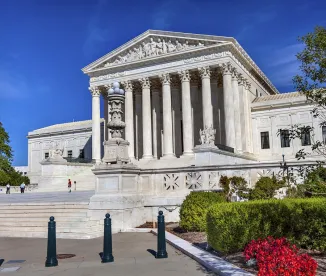U.S. SUPREME COURT ISSUES DECISION IN TEXAS V. NEW MEXICO
In August 2020, we outlined four notable interstate water rights cases before the U.S. Supreme Court that are likely to change how states use and treat water as a resource. One of those cases, Texas v. New Mexico, addresses how states may allocate their respective water rights under an interstate compact if water allocated under the compact evaporates. On 14 December 2020, the U.S. Supreme Court ruled that water held by New Mexico at the request of Texas must be credited as delivered, despite the fact that a significant portion of the water at issue had evaporated. The court’s decision highlights how interstate disputes over shared water resources will likely turn on decisions made by court-appointed third parties, and how unexpected weather events caused by climate change can have long-term consequences for water allocation.
BACKGROUND
The question in Texas v. New Mexico revolves around the Pecos River Compact (Compact), an agreement between Texas and New Mexico apportioning water from the Pecos River1 between the two states.2 The two states entered into the Compact in 1949, with the purpose of ensuring that New Mexico did not reduce the amount of water available to Texas below a certain level. The states have disputed implementation of the Compact ever since. In 1987, following a series of early disputes, the U.S. Supreme Court issued an amended decree appointing a disinterested “River Master” to calculate New Mexico’s annual water delivery obligations under the Compact and adopted a “River Master’s Manual” that governs how the River Master is to calculate New Mexico’s obligations under the Compact.3 In pertinent part, Section C.5 of the River Master’s Manual holds that when water is stored “at the request of Texas” in a facility in New Mexico, then New Mexico’s delivery obligation under the Compact “will be reduced by the amount of reservoir losses attributable to its storage.”4
In 2014, Tropical Storm Odile unexpectedly filled the northern-most Texan reservoir along the Pecos River, named the Red Bluff Reservoir. In response, Texas requested that New Mexico store a portion of the Pecos River water allocated to it under the Compact until Texas had space in the Red Bluff Reservoir.5 New Mexico agreed and stored Texas’ allocated water at the Brantley Reservoir, the New Mexico reservoir nearest the border with Texas.6 While the floodwater was stored in the Brantley Reservoir, 21,000 acre-feet evaporated from the floodwater pool.7 In the spring of 2015, New Mexico notified Texas that its water would soon be released from the Brantley Reservoir. But Texas’ had no room in the Red Bluff Reservoir, since only a fraction of the normal amount of the reservoir’s water had been used for irrigation that year. So, in March 2015, Texas began releasing water from its Red Bluff Reservoir to make room for the water from the Brantley Reservoir, resulting in 40,000 acre-feet of water going unused. In addition, the evaporative losses from the Brantley Reservoir were not discovered until New Mexico began releasing the water in August 2015.8
In 2015 and 2016, the River Master calculated New Mexico’s water delivery obligations for the flood years but did not count as delivered to Texas any of the evaporated floodwater stored in Brantley Reservoir that Texas ultimately could not use.9 In the following years, the states attempted to resolve the question of how the water should be credited but could not reach an agreement.
THE DISPUTE
In mid-2018, New Mexico filed a motion with the River Master requesting it modify its report so that New Mexico would receive a credit for the evaporative losses that occurred while it stored Texas’s allotted water in 2014–2015.10 In September 2018, the River Master ruled in New Mexico’s favor, finding that the storage of water that led to the evaporation had been in response to Texas’s request. As such, the River Master revised his 2015 accounting report to credit as received by Texas the water that evaporated while stored in Brantley Reservoir.11
U.S. SUPREME COURT REVIEW
In December 2018, Texas filed with the U.S. Supreme Court a Motion for Review of the River Master Final Determination, arguing in pertinent part that Texas did not “receive” from New Mexico water that evaporated while in stored in a New Mexico reservoir.12 The question presented was whether the Pecos River Compact allows New Mexico to receive a delivery credit for the evaporated water even though the water ultimately was not delivered to Texas.13
Texas argued that the stored water was not actually part of the “Texas allocation” referred to in Section C.5 of the River Master Manual, that New Mexico did not “store” the water for purposes of Section C.5, and that Texas did not request water be stored after March 2015.
On 14 December, in an 8-0 decision,14 the U.S. Supreme Court found that “Texas requested New Mexico store water at a facility in New Mexico, and New Mexico did so,” and that therefore a delivery credit to New Mexico was appropriate.15 The U.S. Supreme Court noted that the stored water was part of Texas’s allocation under Section C.5 of the River Master’s Manual; that New Mexico did in fact “store” the water as contemplated in Section C.5; and that because Texas did not actually rescind its request for storage before August 2015, the River Master did not err in granting New Mexico a credit for evaporation that took place following March 2015.
RIPPLE EFFECT OF DECISION
The unique nature of the Pecos River Compact, which includes one of only two interstate River Masters in the United States,16 limits some of its precedential value. However, it is notable that the U.S. Supreme Court upheld the authority of the River Master, effectively finding that such a position has the ability to make and enforce legal decisions in the allocation of water rights. The trickle-down effect may mean more deference not only from the U.S. Supreme Court to similar positions such as Special Masters, but also from other courts to interstate water enforcement positions such as Water Masters, in enforcing decrees on other bodies of water.
From a broader perspective, states’ (and industry’s) concerns over evaporative losses, an age-old issue for water rights holders in the West, will be exacerbated by climate change. From small irrigation ditches to vast reservoirs, water rights holders will increasingly need to grapple with how to manage allocating the losses proportionately among various stakeholders. The Court’s focus on the language of the Compact and the River Master’s Manual highlights how important it is for these questions to be considered in stakeholder agreements. Additionally, the Pecos River Compact and the court’s decision to uphold the technical allocation under the River Master Manual provides some guideposts on how these issues and disputes will take shape. Finally, the court’s conclusion also highlights how quick decisions made today in response to unforeseen weather events—decisions which may solve immediate water allocation issues—will have lasting, and perhaps unintended, impacts far into the future.
1 The Pecos River runs from New Mexico southeast into Texas.
2 Motion for Review of River Master’s Final Determination at 1, Texas v New Mexico, No. 22O65 (U.S. filed 27 June 1974) (hereinafter Texas Mtn).
3 Id. See also 592 U.S. ___ at *1 (2020).
4 592 U.S. ___ at *1 (2020).
5 Id. at *4.
6 State of New Mexico’s Response to Texas’s Motion for Review of River Master’s Final Determination at 5–6, Texas v New Mexico, No. 22O65 (U.S. filed 27 June 1974).
7 Texas Mtn at 7.
8 Id. at 7.
9 Texas Mtn at 9.
10 Id.
11 Texas Mtn at 11.
12 592 U.S. ___ at *1 (2020).
13 Id. at *1.
14 Justice Alito Justice concurred in the judgment in part and dissented in part. Justice Barrett took no part in the consideration or decision of the case.
15 Id. at *2 (citing Section C.5 of the River Master’s Manual).
16 While courts have appointed “Special Masters” in several instances to help them resolve water disputes, “River Masters” are appointed by the compacts themselves as an enforcement mechanism. This is similar to intrastate water masters that enforce river adjudications and decrees. The only other interstate River Master governs the Delaware River.






 />i
/>i

